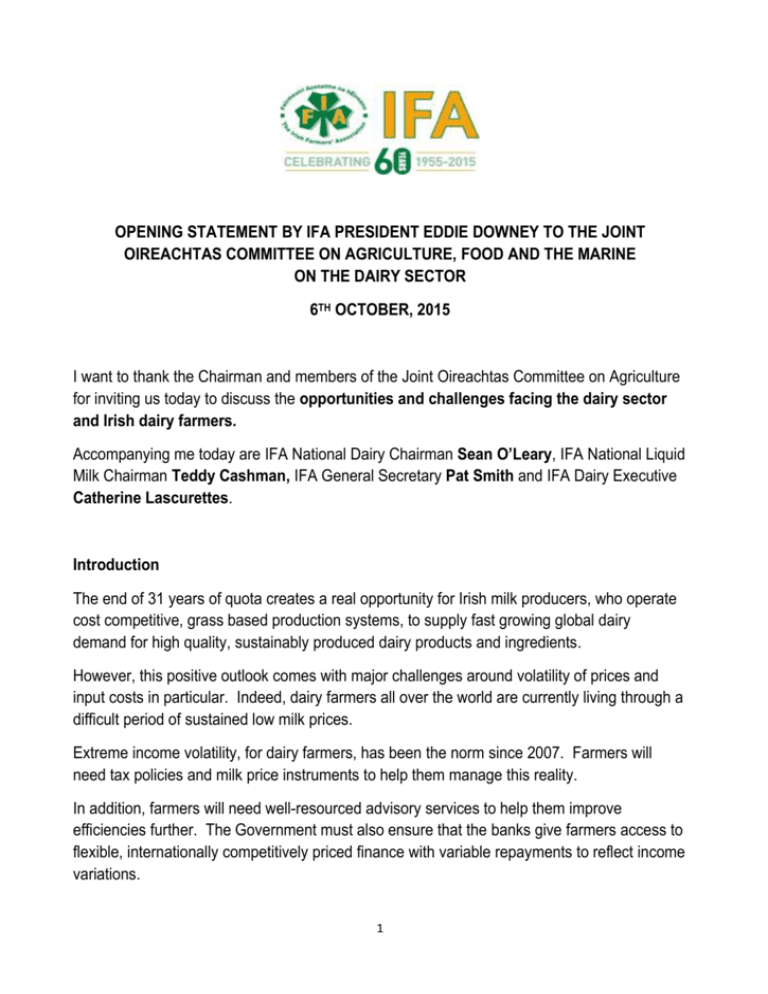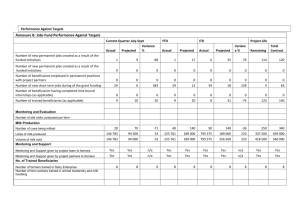Opening Statement IFA Dairy 06-10-2015
advertisement

OPENING STATEMENT BY IFA PRESIDENT EDDIE DOWNEY TO THE JOINT OIREACHTAS COMMITTEE ON AGRICULTURE, FOOD AND THE MARINE ON THE DAIRY SECTOR 6TH OCTOBER, 2015 I want to thank the Chairman and members of the Joint Oireachtas Committee on Agriculture for inviting us today to discuss the opportunities and challenges facing the dairy sector and Irish dairy farmers. Accompanying me today are IFA National Dairy Chairman Sean O’Leary, IFA National Liquid Milk Chairman Teddy Cashman, IFA General Secretary Pat Smith and IFA Dairy Executive Catherine Lascurettes. Introduction The end of 31 years of quota creates a real opportunity for Irish milk producers, who operate cost competitive, grass based production systems, to supply fast growing global dairy demand for high quality, sustainably produced dairy products and ingredients. However, this positive outlook comes with major challenges around volatility of prices and input costs in particular. Indeed, dairy farmers all over the world are currently living through a difficult period of sustained low milk prices. Extreme income volatility, for dairy farmers, has been the norm since 2007. Farmers will need tax policies and milk price instruments to help them manage this reality. In addition, farmers will need well-resourced advisory services to help them improve efficiencies further. The Government must also ensure that the banks give farmers access to flexible, internationally competitively priced finance with variable repayments to reflect income variations. 1 In the COP in Paris in December, the Government must secure climate change legislation which gives them credit for their low carbon footprint in the global context, and which does not prevent them from expanding sustainably. I am now going to hand over to our National Dairy Chairman Sean O’Leary to present the issues in greater detail. A strong positive outlook – with cyclical price and income challenges World population is growing rapidly, with the equivalent of the population of Germany being born each year. It is projected to grow to 9 billion by 2050. Most of the population growth is predicted to occur in emerging countries, and as numbers grow, so will the percentage of those emerging populations classified as middle classes. This is important, because the emergence of more affluent middle classes always coincide with changes in diet. Consumers in those countries ambition to move from poorer quality vegetable protein to higher quality animal protein, often supported by government health related policies (e.g. Chinese school milk scheme). The long term outlook as predicted by OECD/FAO market analysts and confirmed by most experts is for demand to grow somewhat more slowly than in the previous decade, at around 2% per annum, with global supplies chasing it at a slightly slower pace. The potential for countries capable of producing efficiently and sustainably high quality dairy products and ingredients to supply this growing demand is tremendous, and Ireland is one of the very few countries well placed to capitalise on this opportunity. However, volatility in milk prices and input costs has multiplied over the last decade. This is as a result of much greater levels of trade, the quasi-abolition of market supports in Europe, and the greater prevalence of weather events across the world. Economic and geopolitical events, such as the absence of China from the market, the current low oil prices and the Russian ban on EU food imports, have also played a part in worsening price volatility. So, farmers will have to learn to manage the impact extreme fluctuation of prices will have on their income in order to supply this growing demand and fulfil the sector’s economic potential. Solutions for the short and longer term Right now, the biggest issue for dairy farmers is cash flow. Or more to the point, how their cash flow will evolve over the coming months, in the face of low milk prices, high superlevy and tax bills and repayment commitments – and come next spring, with the added challenge 2 of lower milk cheques (relatively smaller volumes and lower constituents meaning lower milk price value). The early payment of up to 75% of the BPS and RDP will provide welcome short term assistance. The distribution of Ireland’s €13.7m share of the EU targeted aid, which we have called on the Minister to match with national funds as explicitly permitted by the EU and distribute equally among all the farmers concerned, will also be of some help. It is also vital that all Rural Development programmes would be fully funded, and that TAMS would be administered efficiently and promptly to allow farmers carry out their investment plans in good time. However, the type of cash flow pressures we are seeing right now will be part of the dairy cycle over the coming years. A suite of policies and instruments must be developed and offered to farmers to help them manage their income for the longer term. The setting up by Minister for Agriculture Simon Coveney of the Dairy Forum is welcome in this respect, and it must be used by the Minister to put pressure on all stakeholders – including banks, industry, government and the EU - to deliver long term viable solutions to the challenges of farm income volatility. The €500m EU aid package voted by Council on 7th September, which enhances APS for dairy products, increases promotion budgets and makes €420m worth of direct payment available to EU dairy farmers will provide some assistance. However, the EU Commission and Council have shied away from doing the one thing that would actually help put a floor on dairy markets and turn them around faster – increasing the so-called intervention safety net so that it is more in tune with actual production costs. The Minister must keep this issue on the agenda and progress it, not play the EU Commission’s game and wait for markets to recover and leave the issue unaddressed, to cause difficulty again when the next price trough arises. Banks and other finance providers must come under greater government pressure to make available to farmers competitively priced, flexible financial products, which allow farmers to take repayment holidays or go on interest only repayments without repricing or renegotiation costs. The Minister must also seek maximum leveraging of the European Investment Bank funds to support the sector, including farmers. With all the stakeholders around the table of the Dairy Forum, we want to see the Minister drive greater engagement from industry around fixed price and margin contracts and other forms of optional price/margin hedging. As yet, too few farmers have access to or even 3 understand the potential value of such contracts to help them manage their business for the long term. A crucial piece in addressing income volatility will be to tackle the EU Commission on state aid rules, in order to increase our ability, at national level, to deliver individualised tax-based solutions. IFA has proposed a detailed scheme to allow farmers to put away funds in good years, to be returned to their taxable income for investment or in poorer years. Such schemes exist in New Zealand and Australia, and in a smaller, more restrictive way, in France. It is essential that we would provide this type of individualised flexibility to assist farmers in managing their volatile income. With Budget 2016 only a few days away, I also take this opportunity to thank members for attending our lobbying session last week. The land mobility initiatives facilitated by last year’s Budget decisions are immensely valuable for new entrants and expanding dairy farmers. However, more can be done to facilitate farm investment: let me remind the Committee of IFA’s proposals to encourage lifetime transfers and farm restructuring by phasing transfers through partnerships and to accelerate capital allowances for sole traders, among others. One element which the Forum did not discuss in its inaugural meeting, and which we cannot and must not shy away from, is the need for efficiency benchmarking at processing level, with a view to identifying savings and removing costs, including through co-operation, and even consolidation. This is an exercise which the industry itself must undertake, but it must be part of the focus driven through the Dairy Forum. Only an optimally efficient dairy processing and marketing sector will be able to deliver on its fullest potential for the Irish economy. Finally, Ireland’s sustainability credentials in milk production, being measured through the Bord Bia Sustainable Dairy Assurance Scheme on every dairy farm, and promoted through the Origin Green campaign, must be given the fullest recognition in Paris at the COP later this year. Liquid milk a particular challenge Part of our team today is our National Liquid Milk Chairman Teddy Cashman. He has invited you to the launch of the IFA Liquid Milk Handbook later this week, and can talk to you later on of the particular concern we have on the sustainability of specialist, contracted liquid milk suppliers in the post quota era. 4 Expansion opportunities do not exist outside of exportable milk, and with intrinsically higher feed and labour costs in delivering milk counter-seasonally, there is a real need to reassess payment structures and regulation within the liquid milk chain to secure fresh, locally produced milk supplies for a sector worth over €500m at retail level. To conclude this opening statement, I hand you back to IFA President Eddie Downey. Conclusion Chairman and Committee members, I am very clear that Irish dairy farmers, with the right supports and help, have a bright future in growing their business to supply quality products for a growing global demand. The difficult situation we are experiencing right now, and will be experiencing for some months, will improve as markets rebalance and prices recover With the right suite of instruments and policies available for them to opt into, farmers can learn to better manage this extreme volatility. We also need delivery in Paris later this year of legal changes recognising our sustainable grass based milk production system to make sure that we are not unfairly restricted from expanding under climate change regulations. Finally, in the race to expand for export, we must not ignore or take for granted our domestic market, especially our liquid milk market. ENDS 5






